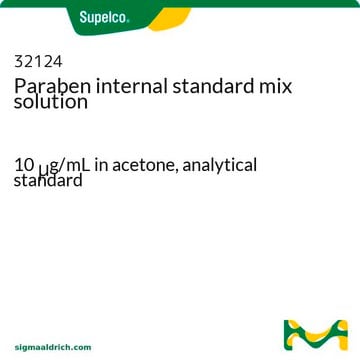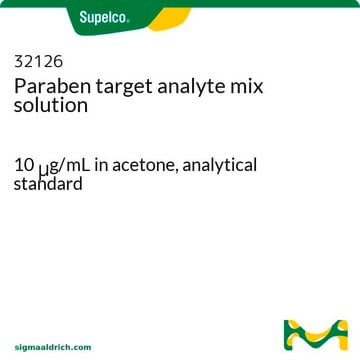47889
Methyl Paraben
PESTANAL®, analytical standard
Synonim(y):
Methyl 4-hydroxybenzoate, p-Hydroxybenzoic acid methyl ester, Methyl paraben, NIPAGIN
About This Item
Polecane produkty
klasa czystości
analytical standard
linia produktu
PESTANAL®
Certyfikat analizy
current certificate can be downloaded
opakowanie
ampule of 1000 mg
metody
HPLC: suitable
gas chromatography (GC): suitable
mp
125-128 °C (lit.)
Zastosowanie
cleaning products
cosmetics
food and beverages
personal care
format
neat
temp. przechowywania
2-30°C
ciąg SMILES
COC(=O)c1ccc(O)cc1
InChI
1S/C8H8O3/c1-11-8(10)6-2-4-7(9)5-3-6/h2-5,9H,1H3
Klucz InChI
LXCFILQKKLGQFO-UHFFFAOYSA-N
informacje o genach
rat ... Ar(24208)
Szukasz podobnych produktów? Odwiedź Przewodnik dotyczący porównywania produktów
Powiązane kategorie
Opis ogólny
Zastosowanie
Polecane produkty
Informacje prawne
Zwroty wskazujące rodzaj zagrożenia
Zwroty wskazujące środki ostrożności
Klasyfikacja zagrożeń
Aquatic Chronic 2
Kod klasy składowania
11 - Combustible Solids
Klasa zagrożenia wodnego (WGK)
WGK 1
Temperatura zapłonu (°F)
334.4 °F
Temperatura zapłonu (°C)
168 °C
Środki ochrony indywidualnej
dust mask type N95 (US), Eyeshields, Gloves
Choose from one of the most recent versions:
Masz już ten produkt?
Dokumenty związane z niedawno zakupionymi produktami zostały zamieszczone w Bibliotece dokumentów.
Klienci oglądali również te produkty
Nasz zespół naukowców ma doświadczenie we wszystkich obszarach badań, w tym w naukach przyrodniczych, materiałoznawstwie, syntezie chemicznej, chromatografii, analityce i wielu innych dziedzinach.
Skontaktuj się z zespołem ds. pomocy technicznej







